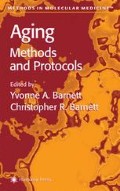Abstract
A rapidly increasing amount of data supports the view that progressive bioenergetic loss caused by injury of the main energy-producing subcellular organelles, that is, the mitochondria, plays a key role in aging. A link between senescence and energy loss is already implied in Harman’s (1) free radical theory of aging, according to which oxygen-derived free radicals injure the cells, with concomitant impairment of performance at the cellular and physiological levels. Further, Miquel and co-workers (2, 3) have proposed a mitochondrial theory of aging, according to which aging results from oxygen stress damage to the mitochondrial genome, with concomitant bioenergetic decline. More recently, a number of laboratories, including our own (4–6), have provided biochemical data in agreement with the above views. Thus, we have shown that, as the result of age-related oxygen stress, mitochondrial glutathione is oxidized in direct relation to injury of the mitochondrial DNA (5). Further, our studies suggest that an antioxidant product extracted from Ginkgo biloba may counteract in part the damaging effects of free radicals on mitochondrial and cellular aging (7).
Access this chapter
Tax calculation will be finalised at checkout
Purchases are for personal use only
References
Harman, D. (1956) Aging: a theory based on free radical and radiation chemistry. J. Gerontol. 11, 298–300.
Miquel, J. and Fleming, J. (1986) Theoretical and experimental support for an “oxygen radical-mitochondrial injury hypothesis of cell aging, in Free Radicals, Aging and Degenerative Diseases (Johnson, J. E., Jr., Walford, R., Harman, D., and Miquel, J., eds.) Alan R. Liss, New York, pp. 51–74.
Miquel, J. (l998) An update on the oxygen stress-mitochondrial mutation theory of aging: genetic and evolutionary implications. Exp. Gerontol. 33, 113–126.
Yen, T. C., Chen, Y. S., King, K. L., Yeh, S. H., and Wei, Y. H. (1989) Liver mitochondrial respiratory functions decline with age. Biochem. Biophys. Res. Commun. 165, 994–1003.
García de la Asunción, J., Millán, A., Pla, R., Bruseghini, L., Esteras, A., Pallardo, F. V., Sastre, J., and Viña, J. (1996) Aging of the liver: age associated oxidative damage to mitochondrial DNA. FASEB J. 10, 333–338.
Sastre, J., Pallardo, F. V., Pla, R., Pellin, A., Juan, G., O’Connor, E., Estrela, J. M., Miquel, J., and Viña, J. (1996) Aging of the liver: age associated mitochondrial damage in intact hepatocytes. Hepatology 24, 1199–1205.
Sastre, J., Millan, A., García de la Asunción, J., Pla, R., Juan, G., Pallardó, F. V., O’Connor, E., Martin, J. A., Droix-Lefaix, M. T., and Viña, J. (1998) A Ginkgo biloba extract (Egb 761) prevents mitochondrial aging by protecting against oxidative stress. Free Radic. Biol. Med. 24, 298–304.
Hagen, T. M., Yowe, D. L., Bartholomew, J. C., Wehr, C. M., Do, K. L., Park, J.-Y., and Ames, B. N. (1997) Mitochondrial decay in hepatocytes from old rats: membrane potential declines, heterogeneity and oxidants increase. Proc. Natl. Acad. Sci. USA 94, 3064–3069.
Chen, L. B. (1989) Mitochondrial membrane potential in living cells. Ann. Rev. Cell Biol. 4, 155–181.
Darley-Usmar, V. M., Rickwood, D., and Wilson, M. T., eds. (1987) Mitochondria: a Practical Approach, IRL, Oxford, pp. 1–16.
Ferrandiz, M. L., Martínez, M., De Juan, E., Díez, A., Bustos, G. and Miquel, J. (1994) Impairment of mitochondrial oxidative phosphorylation in the brain of aged mice. Brain Res. 644, 335–338.
Martínez, M., Ferrándiz, M. L., Díez, A., and Miquel, J. (1995) Depletion of cytosolic GSH decreases the ATP levels and viability of synaptosomes from aged mice but not from young mice. Mech. Ageing Dev. 84, 77–81.
Maftah, A., Petit, J. M., Ratinaud, M. H., and Julien, R. (1989) 10-N nonyl-acridine orange: a fluorescent probe which stains mitochondria independently of their energetic state. Biochem. Biophys. Res. 164, 185–190.
Petit, P. X., O’Connor, J. E., Grunawald, D., and Brown, S. C. (1990) Analysis of the membrane potential of rat-and mouse-liver mitochondria by flow cytometry and possible implications. Eur. J. Biochem. 194, 389–397.
Greenspan, P., Mayer, E. P., and Fowler, S. D. (1985) Nile red: a selective fluorescent stain for intracellular lipid droplets. J. Cell Biol. 100, 965–973.
Royal, J. A. and Ischiripoulos, H. (1993) Evaluation of 2′–7′-dichloro intracellular H2O2 in cultured endothelial cells. Arch. Biochem. Biophys. 302, 348–355, 1993.
Miquel, J., Economos, A. C., and Bensch, K. G. (1981) Insect vs. mammalian aging, in Aging and Cell Structure (Johnson, J. E. Jr., ed.), Plenum Press, New York, pp.347–379.
Author information
Authors and Affiliations
Editor information
Editors and Affiliations
Rights and permissions
Copyright information
© 2000 Humana Press Inc., Totowa, NJ
About this protocol
Cite this protocol
Pallardo, F.V., Sastre, J., Miquel, J., Viña, J. (2000). Causes and Consequences of Damage to Mitochondria. In: Barnett, Y.A., Barnett, C.R. (eds) Aging Methods and Protocols. Methods in Molecular Medicine, vol 38. Humana Press. https://doi.org/10.1385/1-59259-070-5:237
Download citation
DOI: https://doi.org/10.1385/1-59259-070-5:237
Publisher Name: Humana Press
Print ISBN: 978-0-89603-582-9
Online ISBN: 978-1-59259-070-4
eBook Packages: Springer Protocols

